
views
X
Research source
Mapping Your Strategy

Identify your company's mission and vision. The "strategy map," which defines how you're going to achieve your goals as a company, is one of the most important parts of a BSC. Your company's mission goes in the center of the strategy map, with all strategies ultimately helping to fulfill that vision. Communicate your mission or vision succinctly, using no more than a sentence or two. For example, if you run a bakery, your mission might be "To develop and provide healthy, sustainable sweets that create guilt-free smiles."

Start with a box for your traditional financial indicators. The first perspective of a BSC deals with the same financial indicators you would normally include in the company financial report, such as your balance sheet and income statement. In a for-profit company, the basic goal for this box is to increase profits. If you're making a BSC for a nonprofit or government agency, you'll likely use different indicators here, as well as different methods for analyzing improvement. For example, a nonprofit might include fundraising goals here.
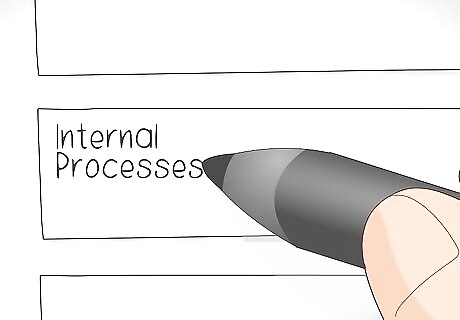
Add a box for your internal processes. The internal processes perspective covers how you get things done as a company. It might include the hierarchy or structure of your company as well as the number of employees that handle each part of your business. For example, if you run a bakery, your internal processes might consist of the vendors you buy your ingredients from, your cashiers or customer service employees, your bakers, and your management staff.

Make another box for your customers' view of your company. The "customer" perspective of the BSC focuses on your customer service and the relationships your customers have with your company. Looking at this perspective, you can figure out how loyal your customers are and how happy they are with the products or services you offer. For example, if you run a bakery, your customer perspective might look at how often customers return and whether they recommend your bakery to friends and family. This perspective also evaluates how you deal with customer complaints and issues that might come up in the course of doing business, such as incorrect or delayed orders.

Include a 4th box for growth and innovation. The last perspective box covers the things you do to grow your company and get it ready for the future. This includes everything from computer and equipment upgrades to employee education. Ultimately, the things you do to grow and improve your company should all work to fulfill the mission you've set. For example, if sustainability is part of your mission, you might focus on upgrading your equipment so that it's more environmentally friendly.
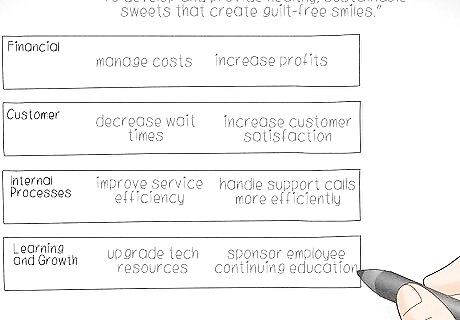
Outline your company's objectives in each of the 4 perspectives. In each of the boxes you've made for the 4 perspectives, list objectives for your company that fall within that perspective. Generally, plan on 2-3 objectives for each perspective. Ultimately, each objective will have 1-2 measures that you can evaluate to determine if your company is on target to reach the objective. Common objectives for each of the 4 perspectives include: Financial: manage costs, increase profits, diversify revenue sources, increase market share Customers: decrease wait times, increase customer satisfaction, improve customer return rate Internal Process: improve service efficiency, allocate resources efficiently, streamline review process Learning and Growth: upgrade tech resources, sponsor employee continuing education, recruit highly skilled employees

Draw arrows to show the relationship between the objectives. Your strategy map shows how the objectives in one perspective might impact objectives in other perspectives. An arrow from one objective to another signals that the second objective improves or develops as a result of work on the first. This creates a chain that you can follow to understand what changes need to come first to achieve all of your objectives efficiently. For example, if you have "decrease customer wait times" in your customer perspective and "handle support calls more efficiently" in your internal process perspective, you would likely draw an arrow from the internal process perspective to the customer perspective. This shows that handling support calls more efficiently would decrease customer wait times.
Choosing Strategic Performance Measures
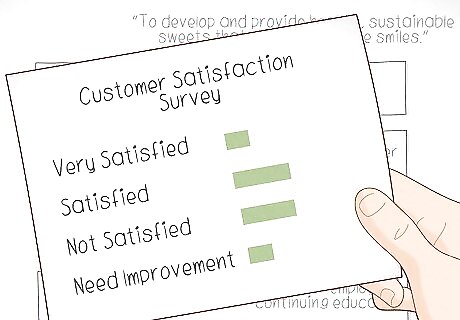
Identify the appropriate measure for each goal. Brainstorm a list of possible measures for each goal, then determine which option is likely to provide you with the most useful information. For goals in some perspectives, such as financial goals, the measures will be fairly standard. However, for other goals, you might have to get a little creative. Financial goals typically use traditional measures, such as your company's operating costs or your profit margin on the products you sell. If you have a goal to make your business more sustainable, you might take a measure of your business's carbon footprint. Then, you could use incremental decreases as your measure of the sustainability goal. Improving customer satisfaction is a goal with several possible measures. You could use the results from a national customer satisfaction survey, but those results might not capture most of your customer base. In that case, you would likely want to create your own survey.
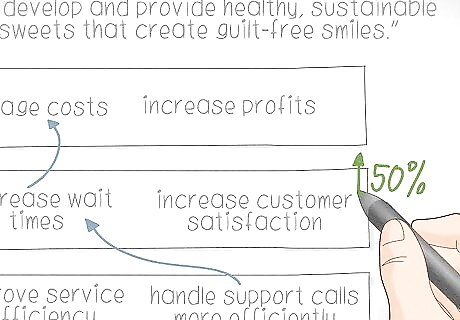
Turn your objectives into specific, measurable goals. Your initial objectives in each perspective are likely vague and unquantifiable. Apply the measure you identified to turn those initial objectives into concrete, actionable goals. For example, if one of your objectives is to improve customer satisfaction, you might decide that you'll know a customer is satisfied if they keep coming back or refer your company to others. You could translate this into a specific goal to increase the percentage of returning customers by 50%. As another example, if you want your business to be more sustainable, you could set a goal of decreasing your company's carbon footprint by 25%.

Define short-term targets for each goal. Targets, or benchmarks, give your company something to work toward and let you know if you're on the right track. Set each target based on periods that you normally evaluate your company's performance, such as quarterly and annual targets. For example, if your ultimate goal is to increase customer satisfaction by 50%, you might set quarterly goals of improving customer satisfaction by 10%.
Launching Strategic Initiatives
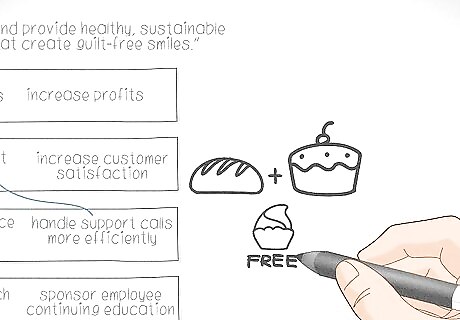
Choose projects that advance your company towards its goals. Strategic initiatives are focused on growing your company and helping it improve. Good projects give you information you can use to make changes that will set your company on the right path to hit its targets. For example, if one of your goals is to increase the number of customers who return to your business, you might implement a survey to evaluate how first-time customers feel about your company and any issues that might keep them from returning. Then, you could work to eliminate those issues.
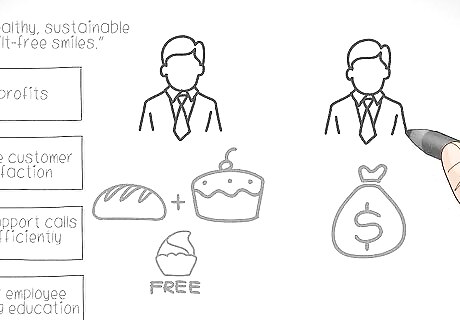
Assign project leaders for each initiative. Having a single person (or team, depending on the size of your organization) in charge of each initiative improves efficiency and ensures employees are accountable for the success of the company. Choose project leaders that have the authority, experience, and resources to manage the initiative. For example, if you have an initiative to improve customer satisfaction, you'd want a customer service employee to lead that initiative, not someone in human resources who isn't in contact with customers. For financial goals, assign an accountant or other financial manager who understands the metrics and how they're calculated.

Allocate company resources to support your various initiatives. Figure out what you'll need to get each of your initiatives off the ground and structure your company's finances to enable the support you need. Some initiatives might only require time and effort while others require an investment in equipment or services. For example, if you're going to do a customer satisfaction survey to evaluate your company's progress towards your objective of increasing customer retention, you'll need to either design a survey or hire someone to design it for you. You'll also need to figure out how you're going to get the survey in the hands of customers.
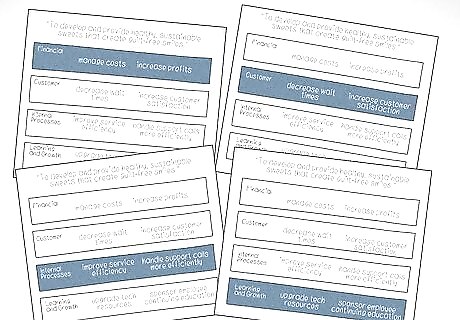
Cascade your strategy map to individual departments. When you "cascade" a BSC, you're simply translating the objectives for the company as a whole into actionable tasks for each department or type of employee. This makes it more specific and ensures everyone understands their specific responsibilities. For example, if you're creating a strategy map for your customer service department, you might focus on the customer perspective and ways they can decrease the wait times for customers who call with a question or service request. Creating strategy maps for individual departments also allows you to delineate specific responsibilities for all of your employees, not just supervisors and management. As you progress down to smaller units, the tasks and objectives become more specific and concrete. For a smaller business with fewer defined units or departments, the maps would be more individualized to address employees directly. For example, if Susan answers customer service calls and emails in your company, you could specify things for Susan to do to help achieve the company's goals.
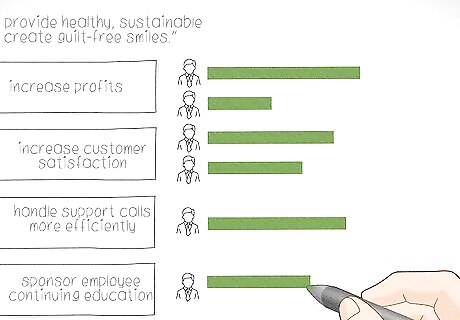
Tie your BSC into individual employee performance. Once you've cascaded your BSC, use the actionable tasks you listed on employee performance reviews. Consider exactly what tasks that employee is responsible for and how good they are at fulfilling them. This tells you if that employee is truly an asset to your company. For example, you might have an employee in sales who is primarily working on follow-up calls and surveying customer satisfaction with your product. Although that employee won't have as many new sales as other employees in their department, they're still providing tremendous value to your company.



















Comments
0 comment